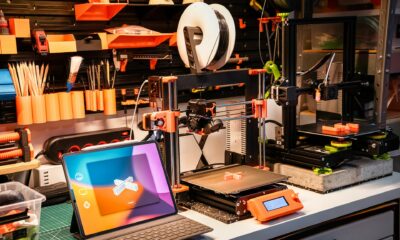Additive Manufacturing
3D-Printed Metamaterials Could Redefine Car Safety
Securities.io maintains rigorous editorial standards and may receive compensation from reviewed links. We are not a registered investment adviser and this is not investment advice. Please view our affiliate disclosure.

Creating Metal Designs
Metallurgy is a technology that has been constantly evolving since the primitive metal craft of early civilization. Until recently, most metalworking was still reliant on techniques like molding (melting metal into hollow shapes) or forging (hammering the metal into shape).
The emergence of 3D printing technology able to handle metallic materials has added an entirely new method to producing metal components, and we are only at the beginning of realizing its potential.
For example, new titanium alloys, hydrogen-infused 3D printing, or geometric printing absorbing vibrations.
Researchers at the University of Glasgow (UK), the Polytechnic University of Marche (Italy), and the National Institute for Nuclear Physics (Italy) have now created a new type of twisted metamaterials that could replace how we build shock absorbers in cars, using 3D printing.
They published their results in Advanced Materials1, under the title “Adaptive Twisting Metamaterials”.
Built-In Shock Absorption
When cars were first built, they had almost no protection against crashes. Then, early impact absorbers such as crash boxes and bumpers provided a single force–displacement response for all crash scenarios encountered during vehicle collisions.
Modern cars are built in a way that, in case of a crash, their frame specifically absorbs most of the kinetic energy, limiting the amount of energy transferred to the passengers.
“The growing need to comply with increasingly stringent and often conflicting safety standards has shifted the focus toward the structural optimization of sacrificial components, advancing the philosophy of mechanical design.”
Together with the widespread adoption of seat belts, this innovation has been a major driver in the reduction of fatalities in car crashes in the past decades.

Source: Haug Farrar
It has mostly been achieved thanks to modifying the structure geometry or incorporating different materials together within proven energy absorbers to enhance energy dissipation.
Still, the energy absorption tends to be constant, no matter the scenario (for example, impact with a pedestrian or a wall), since the force–displacement response remains fixed.
Compression–Torsion Coupling Mechanical (CTCM) Metamaterials
A promising alternative to current methods to absorb shocks is CTCM metamaterials (Compression–Torsion Coupling Mechanical).
They are designed to convert pressure around the axis of the material into a torsion movement, in a corkscrew-like motion, absorbing the impact energy.
This puts CTCM metamaterials one step ahead of simple metal lattices, which are simply compressed under pressure.
These materials fully leverage the capacity of 3D printing manufacturing to create extremely complex shapes and structures, which would be impossible to build by any other method.

Source: Advanced Materials
Force-Dependent Reactions
Previous shock-absorbing materials would essentially either bend or not. So for them to handle major shocks, they often had to resist smaller ones.
“The protective materials used in most vehicles today are static, designed for specific impact scenarios and unable to adapt to varying conditions.”
Instead, STCM metamaterials’ complex shapes can be fine-tuned to specific requirements.
The researchers designed a shape that can absorb a lot of energy even for a small impact, but still provide protection against high-speed/high-energy impact later on.
Following the first crush band (i.e., the initial collapse stress), the ductility of the gyroid-sheet material enabled a stable compressive response without catastrophic failure.

Source: Advanced Materials
This would make STCM metamaterials superior to current conventional foams or crumple zones, as they would provide stiffer resistance to heavy collisions or softer cushioning for lighter impacts.

Source: Advanced Materials
Creating New Shock Absorbers
This result was achieved by creating a complex, highly porous shape known as a gyroid lattice. They then compared the actual parts produced with 3D printing, analyzed with a CT scan, to the CAD computer model.

Source: Advanced Materials
Although the real material somewhat differed from the CAD model, due to metal accumulation being thicker in some areas (11.8% higher density), the actual shock resistance was correctly predicted.
When we apply compression, the gyroid lattice translates it into twist, and by changing the boundary conditions, we can tune the energy absorption characteristics.
These materials can adapt and change their own characteristics depending on the impact type and severity to mitigate effects.
Applications
For now, metal 3D printing has mostly been confined to industries like aeronautics and aerospace, due to the initial high costs of metal 3D printers. This is changing rapidly, as the technology is now maturing and production is scaling up.
“We believe the material could find applications in both automotive and aerospace safety in the future, providing a single new class of material capable of adapting to different needs as required.
It could also support the development of novel forms of energy harvesting, by converting impacts into rotational kinetic energy.”
So in a few years, we could see a new class of adaptive materials against crashes with tunable energy absorption, collapse stress, and stiffness controlled via twisting gyroid structures.
Swipe to scroll →
| Feature | Conventional Absorbers | CTCM Metamaterials |
|---|---|---|
| Response Type | Fixed force–displacement | Adaptive, tunable compression–torsion |
| Material Composition | Foams, honeycombs, metal sheets | 3D-printed gyroid lattices |
| Energy Absorption Efficiency | Moderate, constant | High, variable per impact |
| Manufacturing Method | Casting or forging | Additive manufacturing |
| Potential Uses | Bumpers, crash boxes | Adaptive crash protection, aerospace panels |
At first, the applications are likely to be confined to railway, aerospace, and defense applications, and then make their way into the larger automotive sector, from luxury models to base models.
Investing in 3D Printing
Nano Dimension
Nano Dimension was initially focused on 3D-printed electronics. This includes very specialized technologies like conductive or dielectric inks & ceramics. These can, for example, be used for building optical or radio components.
This is one of the possible applications of 3D printing to the nanoscale, which we explored further in “Nanoscale 3D Printing Looks Primed for Commercialization”.
Nano Dimension Ltd. (NNDM -1.35%)
Notably, Nano Dimension has grown through a mix of acquisitions and internal R&D. This strategy reached a new high with the acquisition of Desktop Metal in 2024.
Together, the 2 companies will have a much stronger position in metal and ceramics 3D printing at all scales, from electronics to large industrial equipment and aerospace. This also creates economies of scale by merging the customer base that includes SpaceX, Tesla, GE, Honeywell, Emerson, Raytheon, NASA, Medtronic, etc.
Lastly, the two companies were mostly active in different geographic areas, with Nano Dimension in Europe and Desktop Metal in the US, allowing for synergy by merging their sales teams.
The company claims it can reduce the ecological footprint of manufacturing, with a reduction of 94% in CO2 emissions, 100% in water, 98% in materials, and 82% in chemicals. Overall, this made Nano Dimension emerge as one of the technology leaders in 3D printing.

Source: Nano Dimensions
Another acquisition that just followed was that of Markforged for $115M. With a focus on composite and metal additive manufacturing equipment, the acquisition of Markforged further reinforces Nano Dimension’s position in the metal 3D printing market.
“The beauty of this merger and the beauty of Markforged and their set of technologies is they’re not overlapping with our technology. The synergies are in the applications for similar companies.”
Yoav Stern- Nano Dimension CEO
The company is also, through acquisitions and internal development, progressing in becoming a leader in 3D printing software.
However, investors need to be aware that the 3D printing industry as a whole is still cash flow negative, so the company will need to cut costs or grow sufficiently to turn a profit in the future.
(You can also read our more detailed investment report regarding Nano Dimension for further information.)
Latest Nano Dimension (NNDM) Stock News and Developments
Top Nanotechnology Stocks To Add to Your Watchlist – October 28th
Nano Dimension Ltd. (NNDM) Q2 2025 Earnings Call Prepared Remarks Transcript
Wall Street Week Ahead
Why Nano Dimension Stock Triumphed on Thursday
Study Referenced:
1. Mattia Utzeri, Maria L. Gatto, Edoardo Mancini, Donato Orlandi, Daniele Cortis, Marco Sasso, Shanmugam Kumar. . Adaptive Twisting Metamaterials. Advanced Materials. 22 October 2025. https://doi.org/10.1002/adma.202513714














